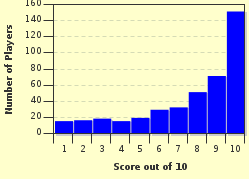Quiz Answer Key and Fun Facts
1. A long time ago, on a continent far, far away (unless you live there), an indigenous population lived in the countries now known as the Republic of the Congo and the Democratic Republic of the Congo. By what name are these diminutive people known?
2. The indigenous population of the Republic of the Congo and the Democratic Republic of the Congo was displaced by a wave of people, believed to have migrated from the area of present day Nigeria. What general term is given to these people who inhabit the largest part of Sub-Saharan Africa?
3. The area now known as the Republic of the Congo and the Democratic Republic of the Congo was first explored and somewhat colonized by Europeans in the 15th century. Which country, known for converting native populations to Roman Catholicism, was the first to establish a presence in the area?
4. In the 1800s, much of the interior area surrounding the Congo River was explored by Europeans for the first time. Which journalist, credited with uttering the famous words, "Doctor Livingstone, I presume", led the expeditions?
5. In 1884, representatives from the major world powers met in Germany for an extensive forum. What was the main purpose of the Berlin Conference (a.k.a. Congo Conference)?
6. Which two neighboring countries had colonial control over the Republic of the Congo and the Democratic Republic of the Congo, respectively, into the 20th century?
7. Who were the Republic of the Congo's Andre Matsoua and the Democratic Republic of the Congo's Patrice Lumumba ?
8. In which swinging decade did the Republic of the Congo and the Democratic Republic of the Congo obtain their independence from their respective colonial overlords?
9. In the early 1990s, changes in the world political scene also affected the Republic of the Congo and the Democratic Republic of the Congo. What changes occurred in these countries, at least on paper?
10. Unfortunately, armed conflicts continued to be waged in the Republic of the Congo and the Democratic Republic of the Congo into the 21st century. Which nearby countries sent troops into both nations in the late 1990s/early 2000s?
Source: Author
PDAZ
This quiz was reviewed by FunTrivia editor
bloomsby before going online.
Any errors found in FunTrivia content are routinely corrected through our feedback system.

